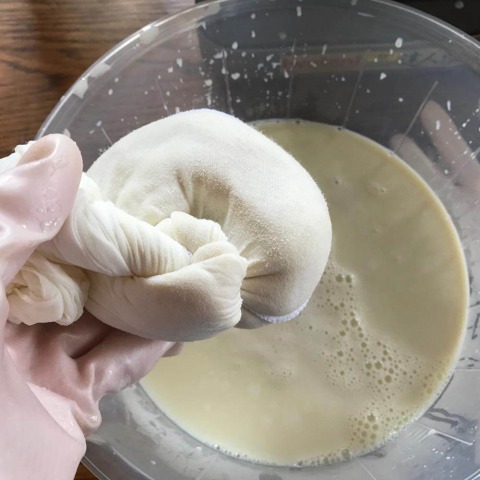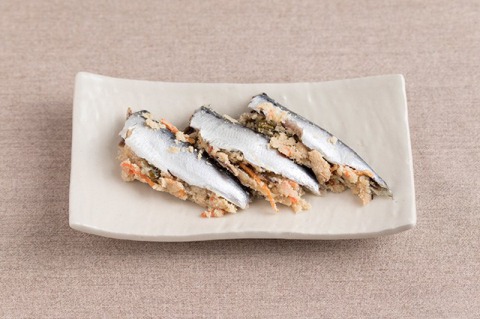- Knowledge Overview
-
Soybean okara is the squeezed lees from the tofu production process. Cookbooks from the Edo period describe cooking methods for soybean okara, which has been used in Japanese cuisine as an ingredient in stir-fried and steamed dishes and soups. In modern Japan, okara powder, which is made by crushing raw okara or dried soybean okara, is also used as a food ingredient in food products. Using the technology that Japan has developed to utilize soybean okara as a food product, it will be possible to develop value-added food products
- Background (history and development)
-
Tofu is believed to have been introduced to Japan from China during the Nara period (710-794), and it was not until the Edo period (1603-1868) that the people began to eat it. By 1782, when a book on tofu cooking called “Tofu Hyakuchin” became extremely popular, tofu began to be consumed all over Japan. Soybean okara (Figure 1) is produced when soy milk is squeezed out during the production process of tofu, and cookbooks published during the Edo period described cooking methods for soybean okara, which was commonly used in Japanese cuisine as an ingredient in stir-fried, steamed, and soup dishes. In modern Japan, raw okara before it is dried or okara powder made by drying and grinding soybean okara is used as a food ingredient in a wide variety of foods. By applying the technology that Japan has cultivated to utilize soybean okara, which is the squeezed lees of soybeans produced when producing tofu, the same technology can be applied to the processing of Sacha Inchi okara, which is the same plant-based protein food, and we aim to develop processed foods from Sacha Inchi okara with high added value.

Figure 1. okara being produced during tofu production
Source: Food Otaku (geek) Magazine (Reference: 11/3/2021), “Homemade from Beans! Let’s make homemade tofu”, https://www.shokuotamagazine.com/shokuotanote_handmadetofu - Specific technology (Specific knowledge of manufacturing methods, work methods, implementation methods, and others)
-
Specifically, okara is produced during the following steps when making tofu.
- Selection of soybeans: Remove contaminants such as split beans, crushed beans, worm-eaten beans, other seeds, and foreign substances.
- Washing: Rinse the soybeans with water several times to thoroughly remove soil and dust from the surface of the soybeans.
- Soaking: To make it easier to grind the soybeans in the next step, they are soaked in water. The soaking time varies depending on the water temperature, so this process also requires consideration of the temperature. Again, remove any contaminants such as split beans, crushed beans, worm-eaten beans, other seeds, and foreign substances.
- Grinding: Soybeans that have been soaked and become large with moisture are crushed into small pieces. In the past, it was ground with a stone mill, but nowadays grinders are commonly used. Grinding helps to break up the soybean cells and extract proteins and other components. Grinding is done while pouring water, and the concentration of soy milk is adjusted depending on the amount of water added. Ground soybeans are called namago.
- Heating: Heat the namago. Heating is used to facilitate coagulation of the soy protein and to maximize elution of the components. In the past, namago was placed in a pot and heated over an open fire (jigama), but now steam heating with a boiler is the mainstream method, and the heating temperature is around 100℃. Heated namago is called nigo.
- Squeezing: To make it easier to grind the soybeans in the next step, they are soaked in water. The soaking time varies depending on the water temperature, so this process also requires consideration of the temperature. This process separates the soy milk and okara (Figure 2).

Figure 2. The process of squeezing boiled soybeans (nigo) and separating soy milk and okara with a strainer cloth.
Source: Food Otaku (geek) Magazine (Reference: 11/3/2021), “Homemade from Beans! Let’s make homemade tofu”, https://www.shokuotamagazine.com/shokuotanote_handmadetofuWhile soybean okara is a highly nutritious food, it is also high in dietary fiber, with a dry and crumbly texture, and has the characteristic flavor and odor of a typical soybean products. However, Japan has developed cooking and processing techniques to overcome these shortcomings.
Nowadays, okara is often treated as food waste, but in the Edo period it was an indispensable ingredient for citizens, filling their stomachs and warming their bodies at a low price. It was also called “kirazu” because it could be used as an ingredient without being cut. Efforts have been made to use them in a variety of cooking methods such as simmered dishes, soups, and furikake; it can be smoothed in a mortar and pestle, roasted until crumbly, simmered with sake, vinegar, mirin, etc., or eaten with fish. (Figure 3)

Figure 3. Unohana (another name for okara) pickled sardines, a local dish of Ibaraki Prefecture, have been valued as a preserved food by combining them with vinegar so that the abundant fresh sardines can be enjoyed for a long time.
Source: Ministry of Agriculture, Forestry and Fisheries (Reference: 11/3/2021), “Our Local Cuisine”、 https://www.maff.go.jp/j/keikaku/syokubunka/k_ryouri/search_menu/menu/iwashinounohanazuke_ibaraki.html - Examples of Applying Knowledge
-
Soybean okara was commonly used as an ingredient in stir-fried, steamed, and soup dishes. For example, in Kochi Prefecture, it used to be the custom to make tofu before New Year’s, and the produced okara during the process was mixed with sticky rice to make mochi, which was eaten at New Year’s. Other diverse uses include seasoning okara and eating it with fish.
In recent years, soybean okara has been attracting attention as a healthy food ingredient that is low in sugar and rich in dietary fiber and protein, and is used in health and diet foods such as cookies and protein bars, as well as in a wide variety of foods such as binder for hamburgers, flour substitute for making sweets, fish paste, chocolate confections and wasabi products.
Although it is not well known in Japan, okara has been used in overseas as well. In Indonesia, it is used as a fermented okara food called okara tempeh, which is attracting attention for its nutritional value. In Europe and the United States, tofu and soy milk were introduced around the 19th century, and in some cases okara was used as an ingredient in bread. Since the 1960s, attention to nutritional aspects has led to the development of various recipes in the United States. In addition, in China, pig farms were set up near tofu shops and used to feed livestock.
- Positioning and Characteristics of Knowledge in Japan
-
Soybean okara is the lees made from squeezing soymilk during the tofu production process. Originally, it would have been discarded after squeezing the soymilk, but it has been effectively used as a resource in Japan since ancient times due to its high nutritional value. Thus, soybean okara is a food familiar to the Japanese.
From the perspective of utilizing the lees after the beans are squeezed, developing countries can similarly utilize the wisdom of making effective use of squeezed lees that are currently discarded. It is known that the problem with using okara is that it is easily perishable, but in recent years, products such as dried okara and powdered dried okara have been developed, and the range of its use has expanded greatly. Even overseas, it is thought that the lees of beans after being squeezed are easily perishable, but by utilizing new technologies such as drying and crushing, it is hoped that underutilized resources can be used effectively.
- Owners/inheritors of knowledge
-
Organizations such as the “Japan Dried Okara Association,” the “National Federation of Tofu,” and the “NIPPON Okara Project” are working to promote the use of tofu okara.
- Related URLs (in Japanese)
-
- Ministry of Agriculture, Forestry and Fisheries. Our Local Cuisine in Kochi Prefecture, Kirazu Mochi. https://www.maff.go.jp/j/keikaku/syokubunka/k_ryouri/search_menu/menu/kirazumochi_kochi.html (Reference: 10/1/2021)
- Ministry of Agriculture, Forestry and Fisheries, New Japanese Local Food (1), https://www.maff.go.jp/j/pr/aff/1301/spe2_01.html (Reference: 10/1/2021)
- National Federation of Tofu, http://www.zentoren.jp/ , (Reference: 11/3/2021)
- Naomi Shibata (Ishiwatari), Development of a Processed Food Product Using Raw Okara as the Principal Raw Material, https://www.jstage.jst.go.jp/article/cookeryscience/49/6/49_355/_pdf/-char/ja (Reference: 10/1/2021)
- Shoko Shimizu, Okara Cooking in Reprinted “Edo Period Cookbook Collection”, https://core.ac.uk/download/pdf/235094439.pdf (Reference: 10/1/2021)
- Ukiyo Kuruma, “Okara, used to keep food warm, was the first health-saving side dish of the ordinary people in the Edo period”, https://diamond.jp/articles/-/51883?page=2 (4/18/2014)
- SoyInfo Center, “History of Soybean Fiber Products: Okara (Soy Pulp) and Soy Bran (Ground Hulls)”, https://www.soyinfocenter.com/HSS/soybean_fiber_products.php (Reference: 11/3/2021)
- Japan Dried Okara Association https://okara.or.jp/ (Reference: 2/1/2022)
- NIPPON Okara Project https://www.okaraproject.com/ (Reference: 2/1/2022)
- National Federation of Tofu (ZENTOU REN) http://www.zentoren.jp/ (Reference: 2/1/2022)
- Forest Business Database for Developing Countries Sacha Inchi Oil https://jifpro.or.jp/bfpro/sanpin/sanpin-03/2023/ (Reference: 2/1/2022)
- Other
-
The wisdom of making effective use of squeezed lees after the beans are squeezed can also be used in developing countries. As an example, in Peru, there is an issue regarding the utilization of the okara-like squeezed lees after extracting oil from the Sacha Inchi nut. Sacha Inchi Okara is rich in high-quality protein, although it is currently underutilized. By utilizing the knowledge of tofu okara, we can develop processed foods and increase added value and recognition. It is expected that the possibility of effective use of resources will expand and distribution will expand.
Your Knowledge could start making a change, when issue is faced; in forest conservation, or in value chains to use forest resources in a sustainable way.


Your Feedback.